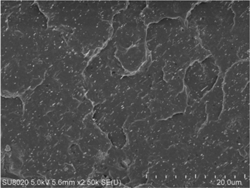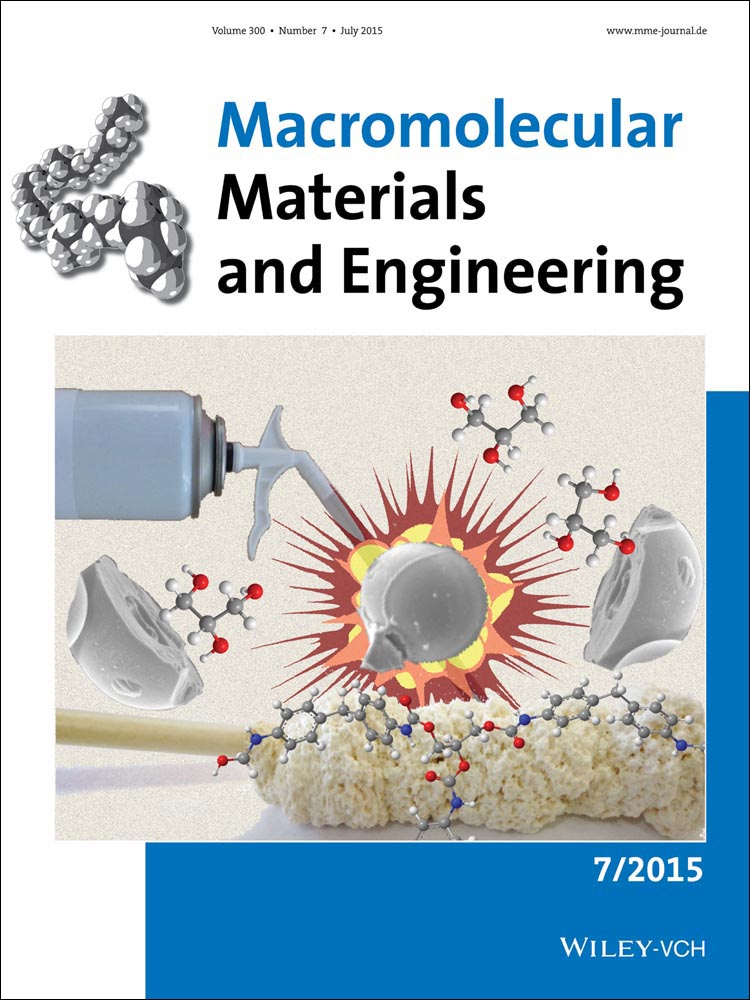Tailoring Polylactide Properties for Automotive Applications: Effects of Co-Addition of Halloysite Nanotubes and Selected Plasticizer
Corresponding Author
Delphine Notta-Cuvier
UVHC LAMIH, UMR CNRS 8201, Le Mont Houy, F-59313 Valenciennes, Cedex, 9 France
Search for more papers by this authorMarius Murariu
University of Mons—UMONS, Center of Innovation and Research in Materials (CIRMAP) & Materia Nova Research Center, 20 Place du Parc, B-7000 Mons, Belgium
Search for more papers by this authorJérémy Odent
University of Mons—UMONS, Center of Innovation and Research in Materials (CIRMAP) & Materia Nova Research Center, 20 Place du Parc, B-7000 Mons, Belgium
Search for more papers by this authorRémi Delille
UVHC LAMIH, UMR CNRS 8201, Le Mont Houy, F-59313 Valenciennes, Cedex, 9 France
Search for more papers by this authorAmani Bouzouita
UVHC LAMIH, UMR CNRS 8201, Le Mont Houy, F-59313 Valenciennes, Cedex, 9 France
Search for more papers by this authorJean-Marie Raquez
University of Mons—UMONS, Center of Innovation and Research in Materials (CIRMAP) & Materia Nova Research Center, 20 Place du Parc, B-7000 Mons, Belgium
Search for more papers by this authorFranck Lauro
UVHC LAMIH, UMR CNRS 8201, Le Mont Houy, F-59313 Valenciennes, Cedex, 9 France
Search for more papers by this authorPhilippe Dubois
University of Mons—UMONS, Center of Innovation and Research in Materials (CIRMAP) & Materia Nova Research Center, 20 Place du Parc, B-7000 Mons, Belgium
Search for more papers by this authorCorresponding Author
Delphine Notta-Cuvier
UVHC LAMIH, UMR CNRS 8201, Le Mont Houy, F-59313 Valenciennes, Cedex, 9 France
Search for more papers by this authorMarius Murariu
University of Mons—UMONS, Center of Innovation and Research in Materials (CIRMAP) & Materia Nova Research Center, 20 Place du Parc, B-7000 Mons, Belgium
Search for more papers by this authorJérémy Odent
University of Mons—UMONS, Center of Innovation and Research in Materials (CIRMAP) & Materia Nova Research Center, 20 Place du Parc, B-7000 Mons, Belgium
Search for more papers by this authorRémi Delille
UVHC LAMIH, UMR CNRS 8201, Le Mont Houy, F-59313 Valenciennes, Cedex, 9 France
Search for more papers by this authorAmani Bouzouita
UVHC LAMIH, UMR CNRS 8201, Le Mont Houy, F-59313 Valenciennes, Cedex, 9 France
Search for more papers by this authorJean-Marie Raquez
University of Mons—UMONS, Center of Innovation and Research in Materials (CIRMAP) & Materia Nova Research Center, 20 Place du Parc, B-7000 Mons, Belgium
Search for more papers by this authorFranck Lauro
UVHC LAMIH, UMR CNRS 8201, Le Mont Houy, F-59313 Valenciennes, Cedex, 9 France
Search for more papers by this authorPhilippe Dubois
University of Mons—UMONS, Center of Innovation and Research in Materials (CIRMAP) & Materia Nova Research Center, 20 Place du Parc, B-7000 Mons, Belgium
Search for more papers by this authorAbstract
Among currently available bio-based polymers, polylactide (PLA) and its (nano)composites have interesting physical and mechanical properties (high tensile strength and stiffness, good processability, biodegradability …). However, they have relatively low thermal stability at high temperature, low toughness and are extremely brittle, all of these drawbacks being obstacles to their utilization in many engineering applications. In this study, PLA-halloysite nanotubes (HNT) nanocomposites are modified by co-addition of a plasticizer (tributyl citrate (TBC)), aiming at reaching mechanical properties suitable for automotive applications. Properties of nanocomposites at different plasticizer contents are characterized with the aim to reach the best compromise between high tensile and flexural strengths and rigidities (ascribed to the matrix and HNT) and impact resistance, ductility, crystallization rat,e and degree of crystallinity, in particular. Results show that plasticized PLA-HNT nanocomposites are very interesting bio-based alternatives for automotive applications, when the plasticizer content is carefully chosen.
References
- 1
R. Auras,
L.-T. Lim,
S.E. M. Selke,
H. Tsuji,
Poly (lactic acid): Synthesis, Structures, Properties, Processing, and Applications,
John Wiley & Sons,
Hoboken, NH, USA
2010.
10.1002/9780470649848 Google Scholar
- 2 R. E. Drumright, P. R. Gruber, D. E. Henton, Adv. Mater. 2000, 12, 1841.
- 3 E. T. H. Vink, K. R. Rábago, D. A. Glassner, P. R. Gruber, Polym. Degrad. Stab. 2003, 80, 403.
- 4 K. Madhavan Nampoothiri, N. R. Nair, R. P. John, Bioresour. Technol. 2010, 101, 8493.
- 5 D. Notta-Cuvier, J. Odent, R. Delille, M. Murariu, F. Lauro, J.-M. Raquez, B. Bennani, P. Dubois, Polym. Testing 2014, 36, 1.
- 6 L. T. Lim, R. Auras, M. Rubino, Prog. Polym. Sci. 2008, 33, 820.
- 7 J.-M. Raquez, Y. Habibi, M. Murariu, P. Dubois, Prog. Polym. Sci. 2013, 38, 1504.
- 8 P. Dubois, M. Murariu, JEC Comp. Mag. 2008, 45, 66.
- 9 M. Murariu, A. Da Silva Ferreira, P. Degée, M. Alexandre, P. Dubois, Polymer 2007, 48, 2613.
- 10 K. S. Anderson, K. M. Schreck, M. A. Hillmyer, Polym. Rev. 2008, 48, 85.
- 11 M. Murariu, A. Da Silva Ferreira, M. Alexandre, P. Dubois, Polym. Advan. Technol. 2008, 19, 636.
- 12 S. Sinha Ray, K. Yamada, M. Okamoto, K. Ueda, Nano Lett. 2002, 2, 1093.
- 13 S. Bourbigot, G. Fontaine, A. Gallos, S. Bellayer, Polym. Advan. Technol. 2011, 22, 30.
- 14 M. Murariu, A. L. Dechief, L. Bonnaud, Y. Paint, A. Gallos, G. Fontaine, S. Bourbigot, P. Dubois, Polym. Degrad. Stab. 2010, 95, 889.
- 15 A.-L. Goffin, E. Duquesne, S. Moins, M. Alexandre, P. Dubois, Eur. Polym. J. 2007, 43, 4103.
- 16 M. Murariu, A. Doumbia, L. Bonnaud, A. L. Dechief, Y. Paint, M. Ferreira, C. Campagne, E. Devaux, P. Dubois, Biomacromolecules 2011, 12, 1762.
- 17 K. Prashantha, H. Schmitt, M.-F. Lacrampe, P. Krawczak, Compos. Sci. Technol. 2011, 71, 1859.
- 18 D. C. O. Marney, L. J. Russell, D. Y. Wu, T. Nguyen, D. Cramm, N. Rigopoulos, N. Wright, M. Greaves, Polym. Degrad. Stab. 2008, 93, 1971.
- 19 N.-Y. Ning, Q.-J. Yin, F. Luo, Q. Zhang, R. Du, Q. Fu, Polymer 2007, 48, 7374.
- 20 M. Zhao, P. Liu, J. Therm. Anal. Calorim. 2008, 94, 103.
- 21 S. Deng, J. Zhang, L. Ye, Compos. Sci. Technol. 2009, 69, 2497.
- 22 G. Cavallaro, G. Lazzara, S. Konnova, R. Fakhrullin, Y. Lvov, Green Materials 2014, 2, 232.
- 23 G. Cavallaro, G. Lazzara, S. Milioto, Polym. Degrad. Stab. 2013, 98, 2529.
- 24 M. Du, B. Guo, D. Jia, Polym. Int. 2010, 59, 574.
- 25 M. Liu, Z. Jia, D. Jia, C. Zhou, Prog. Polym. Sci. 2014, 39, 1498.
- 26 E. Joussein, S. Petit, J. Churchman, B. Theng, D. Righi, B. Delvaux, Clay Min. 2005, 40, 383.
- 27 M. Murariu, A.-L. Dechief, Y. Paint, S. Peeterbroeck, L. Bonnaud, P. Dubois, J. Polym. Environ. 2012, 20, 932.
- 28 W. Wu, X. Cao, Y. Zhang, G. He, J. Appl. Polym. Sci. 2013, 130, 443.
- 29 K. Prashantha, B. Lecouvet, M. Sclavons, M. F. Lacrampe, P. Krawczak, J. Appl. Polym. Sci. 2013, 128, 1895.
- 30 M. Liu, Y. Zhang, C. Zhou, Appl. Clay Sci. 2013, 75–76, 52.
- 31 G. Gorrasi, R. Pantani, M. Murariu, P. Dubois, Macromol. Mater. Eng. 2014, 299, 104.
- 32 R. De Silva, P. Pasbakhsh, K. Goh, S.-P. Chai, J. Chen, J. Compos. Mat. 2013, 0, 1.
- 33 N. Ljungberg, B. Wesslén, Polymer 2003, 44, 7679.
- 34 Y. Lemmouchi, M. Murariu, A. M. D. Santos, A. J. Amass, E. Schacht, P. Dubois, Eur. Polym. J. 2009, 45, 2839.
- 35 D. Battegazzore, S. Bocchini, A. Frache, Express. Polym. Lett. 2011, 5, 849.
- 36 H. Li, M. A. Huneault, Polymer 2007, 48, 6855.
- 37 A. M. Harris, E. C. Lee, J. Appl. Polym. Sci. 2008, 107, 2246.
- 38 M. L. Williams, R. F. Landel, J. D. Ferry, J. Am. Chem. Soc. 1955, 77, 3701.
- 39 P. Yuan, P. D. Southon, Z. Liu, M. E. R. Green, J. M. Hook, S. J. Antill, C. J. Kepert, J. Phys. Chem. C 2008, 112, 15742.
- 40 P. D. Ritchie, Plasticizers, Stabilizers, and Fillers, The Plastics Institute, Iliffe Books, Ltd., London 1972.




